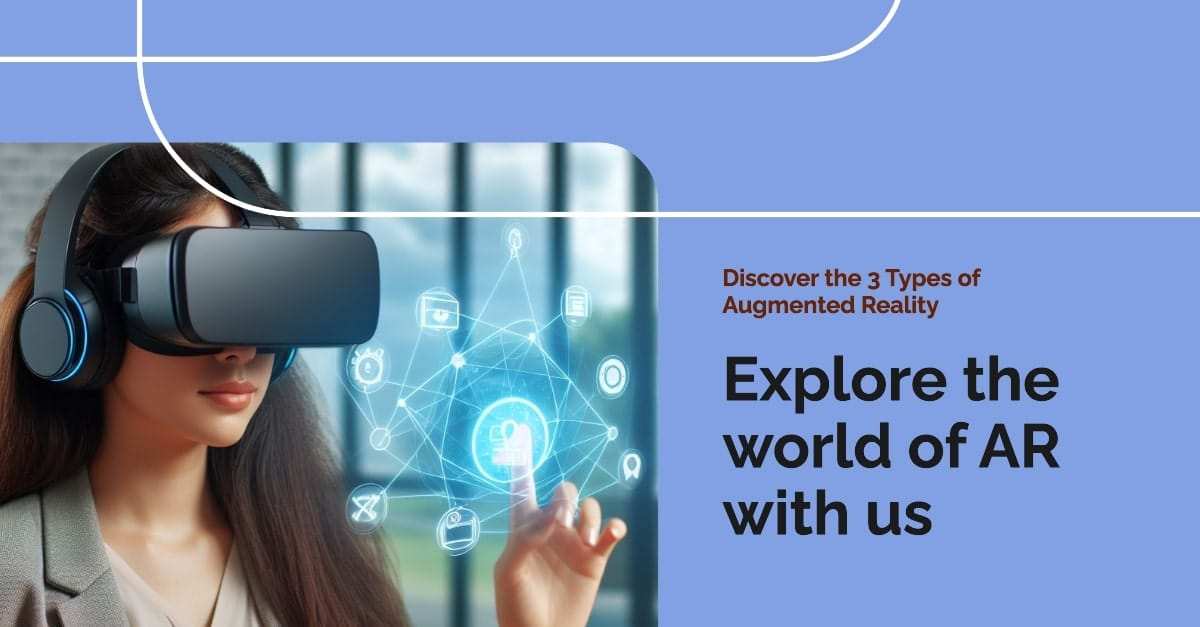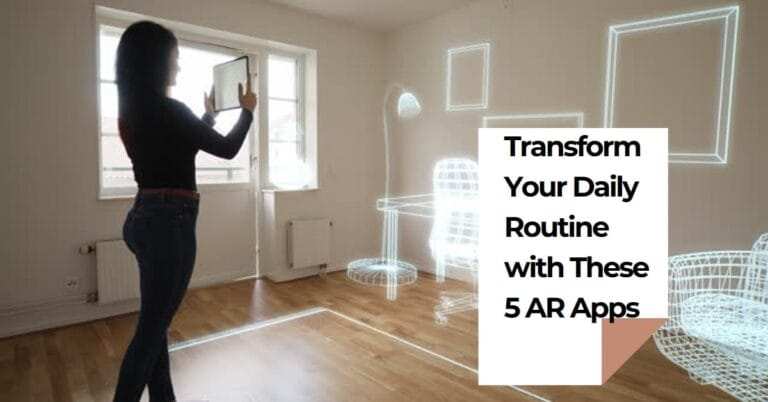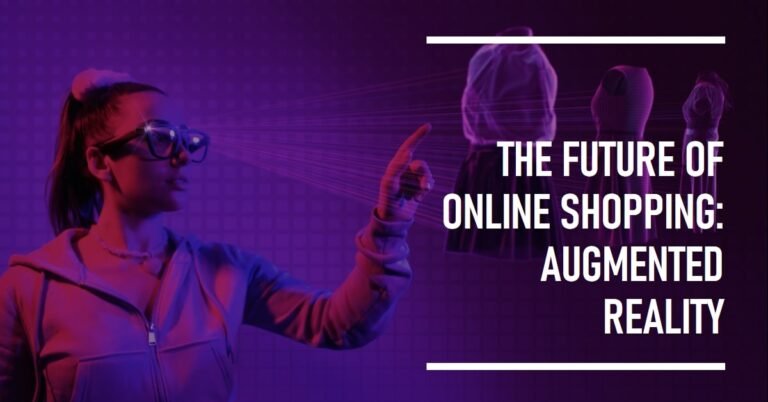What Are The 3 Types Of Augmented Reality?
Have you ever wondered how those cool dinosaur apps let you see life-sized T-Rexes roaming around your living room? Or how furniture stores allow you to virtually place a couch in your space before you buy it? That’s the power of Augmented Reality (AR) at work!
AR overlays digital information onto the real world, creating an interactive experience that blends the physical and virtual seamlessly. But how exactly does it work? There are three main types of AR, each with its unique approach:
- Marker-Based AR
- Markerless AR
- Projection-Based AR
Let’s delve deeper into each type and explore how they’re changing the world around us!
Marker-Based AR: Decoding the Hidden
Imagine pointing your phone or tablet at a picture on a museum exhibit, and suddenly, the image comes alive with 3D animations or informative videos. That’s the magic of marker-based AR.
Here’s how it works:
- A visual marker, usually a black-and-white image with unique patterns, acts as a trigger.
- The AR app on your device detects the marker using the camera.
- Once recognized, the app overlays pre-programmed digital content onto the marker’s location in real-time.
Real-Life Example: Imagine you’re visiting a historical landmark. By pointing your phone at a designated marker on a plaque, you can see a 3D recreation of the building in its former glory.
Benefits:
- Simple and easy to set up.
- Ideal for educational purposes and product packaging.
- Cost-effective for developers.
Limitations:
- Requires pre-designed markers, limiting flexibility.
- Can be disruptive to the user experience if markers are not readily available.
Markerless AR: Unleashing the Potential
Markerless AR takes AR a step further, eliminating the need for physical markers. It relies on sophisticated technology to understand the environment and superimpose digital content. Here are the key approaches:
- Location-Based AR: Uses GPS, cellular data, and Wi-Fi to determine your location.
- SLAM (Simultaneous Localization and Mapping): Creates a real-time map of your surroundings using your device’s camera and sensors. This allows for highly accurate placement of digital objects in the environment.
- Object Recognition: Identifies and tracks specific objects in the real world, enabling interaction with virtual elements.
Real-Life Example: Many popular location-based AR games use GPS to overlay virtual creatures onto your real-world surroundings. With furniture shopping apps that use object recognition, you can virtually place a sofa in your living room to see how it looks before you buy it.
Benefits:
- More immersive and interactive experience.
- Offers greater flexibility and a wider range of applications.
- Doesn’t require pre-designed markers.
Limitations:
- Requires more powerful devices and processing capabilities.
- Accuracy can be affected by GPS signal strength and indoor environments.
Projection-Based AR: Painting the World with Light
Projection-based AR takes a different approach altogether. It uses projectors to beam digital content onto physical surfaces, transforming them into interactive displays.
Here’s how it works:
- A projector displays digital images onto a specific surface.
- Sensors or cameras track user interaction with the projected image.
- The system responds accordingly, creating an interactive experience.
Real-Life Example: Imagine walking into a clothing store where walls project different outfits onto mannequins. You can use gestures to change the clothes or even virtually try them on yourself.
Benefits:
- Creates a large-scale interactive experience.
- Ideal for retail displays, interactive art installations, and educational exhibits.
Limitations:
- Requires specialized equipment and setup.
- Limited by the size and surface of the projection area.
So, Which Type of AR Should You Choose?
The best type of AR for your needs depends on your specific goals and resources. Here’s a quick guide:
- For simple applications and educational purposes, marker-based AR is a good starting point.
- If you need a more immersive and location-based experience, markerless AR is the way to go.
- For large-scale interactive displays and retail experiences, projection-based AR offers unique possibilities.
The Future of AR: A World of Possibilities
The three main types of AR – marker-based, markerless, and projection-based – are just the foundation. As technology continues to evolve, we can expect even more exciting developments in the field of AR. Here are some glimpses into the future:
- Ubiquitous AR: Imagine a world where AR seamlessly integrates into our daily lives. Imagine seeing restaurant reviews overlaid on building facades, navigational directions appearing on your windshield, or educational information popping up as you explore historical sites. AR glasses that are lightweight, comfortable, and widely accessible will be key to this ubiquitous future.
- AR Cloud: A shared network for storing and accessing AR experiences. Imagine downloading and experiencing a virtual museum exhibit created by someone halfway across the world. The AR Cloud will enable collaboration, content sharing, and the creation of persistent AR experiences that can be accessed and interacted with by multiple users simultaneously.
- AR for Social Interaction: AR can revolutionize the way we connect with others. Imagine playing interactive games with friends remotely, virtually collaborating on projects in real time, or even enhancing video calls with shared virtual objects. AR can bridge the gap between physical and virtual spaces, fostering deeper social interactions.
The Impact of AR: Beyond Entertainment
AR has the potential to revolutionize various industries beyond just gaming and entertainment. Here are some exciting possibilities:
- Education: AR can transform classrooms into interactive learning environments. Imagine dissecting a virtual frog in biology class or exploring the solar system in a 3D model.
- Healthcare: AR can assist surgeons with real-time patient data overlays during operations or help patients with physical therapy exercises through interactive guidance.
- Manufacturing and Design: AR can allow for remote product inspections and maintenance, or provide engineers with 3D overlays for visualizing complex designs.
- Retail: AR can enhance the shopping experience by allowing virtual product try-ons or providing customers with interactive product information.
Conclusion
The world of AR is brimming with possibilities. Whether you’re a developer, designer, educator, or simply a curious individual, there are ways to get involved and explore the potential of AR. Here are some steps you can take:
- Download AR apps and games: Experiment with existing AR applications to get a feel for the technology. Many free and paid options are available for various devices.
- Explore AR creation tools: If you’re interested in creating your own AR experiences, there are user-friendly platforms available that don’t require extensive coding knowledge.
- Stay informed: Keep up-to-date with the latest AR developments by following industry news and attending AR conferences or workshops.
AR is still in its early stages, but it holds immense promise for the future. By understanding the different types of AR and exploring their potential applications, we can unlock a world of new possibilities and create a more interactive and engaging tomorrow.
Ready to dive into the world of AR? The future is waiting!






